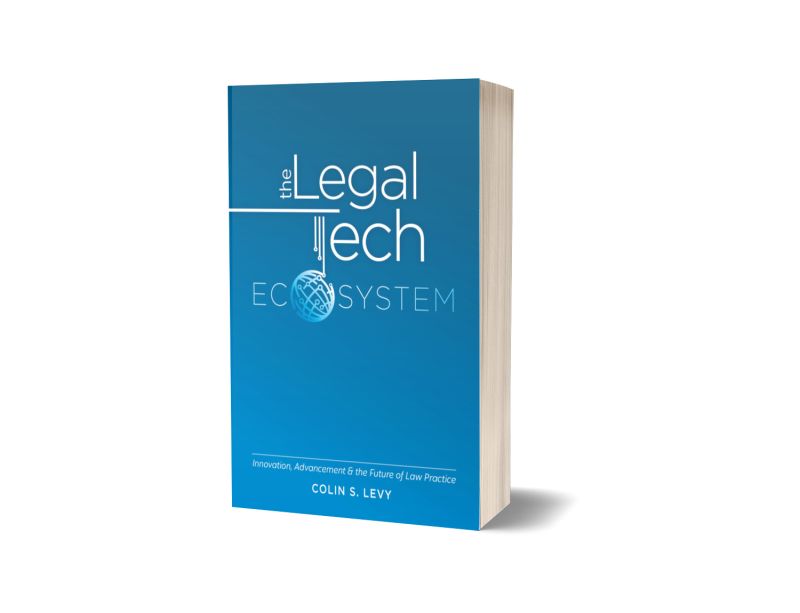Author: Colin S. Levy, Chief Lawyer @ Malbek, Legal Tech Author and Commentator, Fastcase 50 2022 Honoree, Legal Tech Startup Advisor and Investor
BOOK EXCERPT. GENERATIVE ARTIFICIAL INTELLIGENCE.
ChatGPT has generated a lot of attention given its remarkable interactivity and innate ability to respond to requests quickly—and in plain and simple language. Yet ChatGPT is but one of many examples of what is called Generative Artificial Intelligence. Generative AI is a blanket term used to describe any form of AI model that creates content such as imagery, video, text, audio, or even code. Unlike other AI models, Generative AI creates new outputs based on data that the model has been trained on. That is what makes Generative AI exciting because unlike other types of AI, Generative AI models create new content, and that content can take many forms.
While the content that gets created can vary, Generative AI has some common characteristics regardless of the content that gets created can vary, Generative AI has some common characteristics regardless of the content that gets created. Before I describe what those are, let’s touch upon AI that is not generative. AI that is not generative is called discriminating artificial intelligence—discriminating because its purpose is to decide, e.g., provide a judgment based on given inputs whether a contract contains a keyword or a critical clause. The AI model is trained to make these decisions based on provided parameters.
Generative AI models typically take one of several forms. Two of the forms more commonly used by everyday people are either a visual generating tool that can create some type of media—e.g., video, audio, or both—or a text-generating model (also called a Generative Pre-Trained model or GPT for short). The content that is created can then serve as a useful starting point for artists, musicians, and writers for brainstorming, outlining, and exploration. Additionally, these applications can create things quickly and in larger quantities than a human can. What could otherwise be time-consuming, repetitive, and costly tasks can now be done efficiently.
There are also some definite risks that come with using Generative AI. One such risk is bias. A biased set of data will also make the model biased. Such bias may be hard to detect at first if the person compiling the data is unaware of a bias within the data because they, themselves, are biased and do not recognize their bias.
What also contributes to bias is the quality and scope of the data sets used to train the models. If those data are limited, inaccurate, or incomplete, the model will produce outputs that are also biased, limited, or inaccurate. A Generative AI model requires an enormous amount of data, some of which could become outdated quickly.
A final risk that comes with using Generative AI is that as more data is provided to it, its outputs can be unpredictable, hard to control, and sometimes even fail to meet what a user expects of it.
AI is making rapid advancements and these advancements are the harbinger of more changes to come. The rise of sophisticated large language models such as GPT-4 represents a major advancement in the ability for technology to be used to complete complex research and writing projects.
Consider litigation as one space where AI can make a tremendous impact. From researching caselaw and drawing out trends, analyses, and winning arguments in previously used legal briefs to extracting key datapoints from troves of documents produced during the discovery phase of a litigation matter, technology can perform tasks that would take hours, days, even weeks or months for humans to complete by themselves.
AI solutions can also produce first drafts of briefs, anticipate potential opposing counsel arguments, and even predict the probability of a winning argument. Casetext, for example, has an AI-based tool called CoCounsel, which answers inquiries traditionally asked of new lawyers about a case or area of law. Many more such tools are poised to be released with increasingly sophisticated capabilities.
In the contract management area, AI tools leveraging machine-learning and natural-language-processing algorithms can assist with reviewing contracts for key terms or risks, interpret contract terms, and even predict potential risks based on historical data. Such tools can assist in helping draft alternative clauses when an agreement is being negotiated or identify trends or patterns with a series of contract negotiations or contractual sales cycles.
Additionally, and importantly, AI tools have tremendous potential to make accessing legal services cheaper and easier by providing consumers of legal services with access to self-service tools and documents without needing to engage a costly lawyer or pursue costly litigation. Disputes can now be resolved online without needing to set aside time to go to court. Companies, like SixFifty and Gavel, allow for individuals, startups, and smaller firms to create and access resources to succeed and establish themselves at a much lower expense and far faster than could be done historically.
Yet, to fully realize the benefits of using AI requires awareness and proficiency in using these tools, including knowing how to ask the right questions to get the right answers or information needed. Additionally, as technologies grow in power and abilities, the ethics around proper use of such tools remain woefully underdeveloped. More work is needed to provide frameworks around the use of such tools.
Law firms and law schools should update their curricula to incorporate technological awareness, proficiency, and ethics to help ensure their employees and graduates are positioned to thrive in a world increasingly reliant on and driven by technology.
Given that context is of supreme importance in human interaction combined with an inherent moral compass and emotional intelligence, AI tools are set to continue to be just tools. Thus, while it is critical to recognize the profound impact of AI on the legal sector, it would be erroneous to understate the enduring importance of human contributions in the practice of law.
IS AI NECESSARY?
One might question whether AI is necessary. Although many legal technology products have moved beyond simple automation, the industry as a whole still hasn’t moved far enough that substituting high-speed, high-frequency machine learning for human intelligence is required (or even possible) in many implementations. But even if it is not needed now—and isn’t really ready, either—AI and legal tech products that incorporate AI will remain in development. The picture of AI in legal technology could look very different in just a few years.
I first met Bjarne Philip Tellmann when we worked together at Pearson Education. My blog was then in its early stages and Bjarne was instrumental in inspiring me to continue with it. He is a longtime legal leader, former assistant general counsel of Coca-Cola, former general counsel of Pearson Education, and now general counsel of health care company Haleon. He has engaged in several digital transformation projects, including using tools that made use of AI. I spoke with him about AI’s current state and its future in the legal space.
“So-called AI has the potential to radically change the way we practice law. I don’t think we are there quite yet, but we are seeing the stirrings of it, especially in the finance sector, where the tremendous volume supports its use.
“For example, J.P. Morgan developed a contract analytics tool used to analyze commercial loan agreements. It has replaced human analysis and the 360,000 hours of human work required to analyze those agreements. That is massively powerful. Within the next 20 years, we will see the massive impact of it as it moves up the food chain. The speed and processing power of the algorithms in use— what’s called AI—will increase exponentially, and that cannot do anything but radically transform the practice of law.
“However, AI can’t do everything. At Pearson Education, we did a study with the Oxford Martin School about jobs of the future, and we found that lawyers will be the third most in-demand job between now and 2030. This is because of some skills lawyers possess that machines cannot easily duplicate, such as originality, creativity, and empathy.
“Another thing to keep in mind is that a lot of what lawyers do, broadly speaking, has a big impact on human beings. For example, if you were facing the death penalty, would you want a machine to tell you that? There are limits to what we want from machines and limits to what technology will do in the medium term, that is, the next 20 years. As for the long term—the next 100 years—who knows?”
For a broader perspective on AI and its developing role within the legal space and society at large, I turned to Kenneth Grady, whose diversity and wealth of experience has given him a uniquely balanced perspective on the purpose of and benefits of AI now and in the future.
Kenneth A. Grady has been a general counsel, law firm partner, law firm subsidiary CEO, legal industry consultant, and adjunct professor and research fellow. Ken focuses on how lawyers, law firms, and law companies can become innovative, efficient, and affordable legal service providers. He sees things from the perspective of clients, but also has the insights of service providers. I asked him what he thought about the role of AI in the ongoing evolution of law practice, and how attorneys might adapt to the rise of AI-driven tools. He responded:
“Right now, I think the best way to think about AI and law is to break it into two categories. The first category covers AI as a tool in the legal industry, and the second covers the impact of AI as a tool on law and society.
“As a tool in law, AI can help us in many ways, and it can hurt us if we misuse it. In that regard, it is similar to understanding how to use current tools, such as online legal databases. As a lawyer, you need to understand the tools available to you, how to use them, and what they can and cannot do. You have to incorporate them into your practice when it makes sense. Lawyers can leverage AI to free the lawyer to do things AI can’t do. Lawyers can also use AI to augment what they do. For example, AI can review thousands of documents in a fraction of the time and with higher accuracy than a lawyer—but AI can’t interpret the results of that review. Combined, the lawyer plus AI will deliver a higher-quality product, in less time, and at lower cost than either could do alone.
“Outside the legal industry, AI is having a major impact on society. Laws that were written for human agents should be reconsidered, given that humans are being replaced by the complex algorithms that constitute AI tools. There are many circumstances in which AI can do something, but the real question is, should it do that some- thing? In what settings should we regulate AI? How will tort law handle the volume of data AI uses to answer causation questions? How do we test the integrity of algorithms?
“This second area is especially interesting because technologists are driving forward with their own approaches to answering these questions. They are not waiting for lawyers to tag along. Put bluntly, law is slipping away from lawyers to technologists. This is a historic shift and one that has some very deep implications for society and rule of law.”
Ron Friedmann is a thought leader in the legal innovation space, with more than 20 years’ experience in the legal field. Ron is an expert in law practice management, outsourcing, knowledge management, contract management, e-discovery, legal marketing, and technology for lawyers. I asked his opinion of the use of AI in the practice of law.
“AI likely will increase client value, but it will take more time than the hype in past years suggested. Common use cases today include document review in discovery and due diligence, legal research, and court analytics, and faster, more accurate ways to classify time narratives and matter types.
“In particular, with software providers embedding the powerful algorithms that constitute AI in core document management systems and enterprise search, we can expect AI to deliver actionable information to lawyers in real time.”
Check out the book via this link








